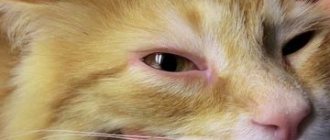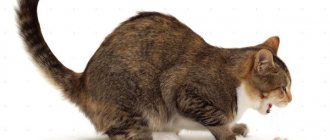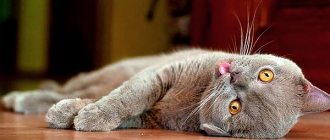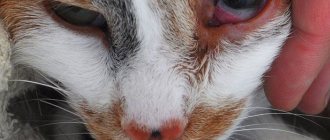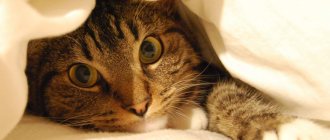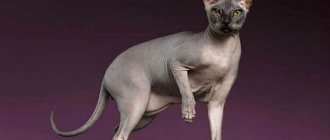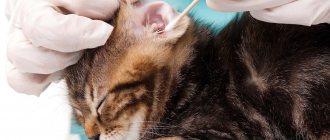Main reasons
Stress and nerves
A common reason that causes wide pupils.
If the animal senses something is wrong or becomes very frightened, visual functions become more acute. This helps to notice danger in a timely manner and respond to it immediately. Unfamiliar surroundings, strangers and objects in the house also make the animal worried and wary. There is a breed of cat, for example, the Singaporean, which has a highly developed maternal instinct. The mother cat constantly protects and protects the kitten, and if the baby is suddenly separated and given to other owners, the animal will begin to worry a lot and cannot find a place for itself. Due to stress, the pupils immediately dilate, the cat becomes wary, and may stop trusting the owner and hide the rest of the kittens.
Natural causes
- Estrus and the call of nature. During the period when cats of both sexes need a sexual partner, and hormones are raging in the body, a lot changes - behavior, physiological indicators, and some metabolic processes. So, if you see dilated pupils on your pet during estrus, you shouldn’t be scared - this is normal. In addition, other signs appear: the animal begins to visit the litter box more often (urination increases), the cat breathes with its mouth open in an attempt to smell the female, intensive licking of the perineum begins, and so on. As a rule, this goes away with the end of estrus, and the cat's pupils become normal sizes.
- The cat is alarmed and nervous. A state of stress, depression or a constant feeling of anxiety also affects the size of the pupils. Many owners who have just got a shaggy pet have noticed that the cat's pupils, regardless of the lighting in the room, are constantly dilated. And this can be explained very simply - the cat has not yet settled into its new home, has not gotten used to it and has not studied the situation, so it expects an attack from an unknown enemy every minute. A similar reaction is observed when another relative begins to live in the neighborhood and you have to share territory and other things with him. In such cases, the pupils become very wide, plus this is accompanied by caution and constraint in movements, insinuating. Especially if the “alien” is nearby. After some time, the pet will get used to its new neighbor, and the pupils will become normal again.
- Games, hunting, movement. When a cat is resting (not necessarily sleeping), the pupils are usually narrow. And with the onset of evening, a normal cat begins to move, and a wild desire to play begins. And as soon as she starts jumping around the house, looking wildly at her surroundings, you can notice that her eyes turn into giant “saucers”. Thus, they respond to the release of adrenaline into the body. This is a completely natural and even necessary process for the animal: you can better see the outlines of objects encountered along the road, while deftly dodging them and without the risk of injury. Moreover, the chance of seeing prey increases, which, according to the cat’s estimates, will definitely appear from some secret corner (the owners know that there are no mice behind the closet, and the cat’s hope is so great!).
- The world around is full of dangers. The cat's pupil is unique and can instantly change shape if the cat suddenly sees danger. If, for example, the owner intends to dip an experienced feline person into a bath of water, then the eyes of the indignant, indignant cat will turn into two barely noticeable slits. The gaze will be focused on the potential victim, who definitely needs to take revenge. And the inexperienced, naive young cat will have one desire - to find out who the villain is who threw her into the water. And, gripped by fear and uncertainty, she will try to take in the entire room with her gaze, and the pupils will dilate, filling the entire eye space.
We suggest you familiarize yourself with: Desert caracal or steppe lynx
Eyes become huge due to frightening loud sounds from nowhere, incomprehensible rustles and other surprises that traumatize the cat’s peace.
The cat's eyes are watering: why and what to do?
Why doesn't a cat respond to its name?
Of course, she doesn’t respond not because she doesn’t hear you. On the contrary, scientists have proven that most cats know their names well and recognize the voices of their owners. The thing is, cats don't always want to react.
- She can just sleep, eat, play...
- Or simply accept that he doesn't need to get close to his owner at the moment.
- If he needs something, the cat will find you and come to you.
The above description may sound cynical, but such reasoning simply follows the cat's nature. The cat follows its instinct, which tells it to act in situations of immediate danger. However, if nothing is going on, most cats don't see the need to interact excessively with people. And there is no malice in this.
Dangerous symptoms
If a cat has constantly dilated pupils as a result of any internal disorders, there will certainly be accompanying symptoms that cannot be ignored. It is dangerous to postpone a visit to the doctor if the following pathological signs are additionally observed:
- the pupils are always dilated and do not react to light;
- fields of vision are narrowed;
- corneal clouding;
- redness of the conjunctiva;
- photophobia;
- hanging lacrimation;
- rapid breathing;
- nausea, vomiting, the cat staggers when walking;
- eyes constantly dart, the animal cannot concentrate its gaze at a certain point;
- stiffness of movement, disorientation;
- temperature increase.
When to sound the alarm
If a cat is at rest and in normal daylight, but at the same time one or both pupils are dilated, then this clearly indicates some deviations in the general condition of the animal. This condition should definitely alert the owner. In any case, you should definitely show your cat to a veterinarian, because... There are a lot of reasons for this phenomenon, and only a specialist can determine the exact one. It is also important to understand that the very fact of dilated pupils is not as scary as their lack of reaction to light stimuli.
Alarming symptoms
Eye diseases If the cat’s health and mood are fine, but the pupils are of different sizes or are dilated all the time, then we can say that the eyes are affected by a disease. As vision decreases, light sensitivity decreases and the pupils do not constrict. If both eyes are sick, both pupils will be round, but if they are different, only one eye is sick, and the other reacts the same way to changes in lighting.
Most often, different eyes occur with the following diseases:
- closed glaucoma;
- retinal atrophy;
- dislocation of the eye lens;
- the ocular blood supply is impaired;
- posterior uveitis.
These diseases are fraught with considerable danger and can make the animal blind. And it doesn’t matter that treatment was started in a timely manner. Therefore, it is better to immediately visit an ophthalmologist-veterinarian.
Endure pain Another bad reason for dilated cat pupils is constant, incessant pain. Cats are quite patient and never show how much pain they are in. They are patient with cramps, spasmodic manifestations, and never complain when injured, etc. Therefore, it is rare that an owner notices that his pet has been suffering from pain for several weeks in a row.
If the cat moves little, takes an unnatural position while sleeping, its gait is constrained - this may be the cause of aching constant pain (kidneys, stomach, heart hurt, a part of the body is affected by a tumor, an infection has begun, and so on).
If your pet constantly has wide pupils, you need to immediately run to the veterinarian! The specialist will do the necessary tests, assess the cat’s condition and prescribe the necessary course of treatment.
We suggest you read: Why does a cat itch if there are no fleas?
Poisoning When a cat, along with large pupils, experiences poor coordination of movements, nausea and vomiting, we can say with complete confidence that the animal has been poisoned. You should pay attention to how often vomiting occurs, the intensity of the eye's reaction to light, and take your animal to the veterinarian. Usually, dilated pupils indicate poisoning with substances that are difficult to remove from the cat’s body on their own. For example, a pet could be poisoned by medications, some plant containing poison, or food of poor quality (or poisoned).
Age, old age Very often, dilated pupils are observed in old and elderly cats. Vision deteriorates, becomes weaker, and the cornea becomes clouded. Old animals no longer constrict their pupils when it is light; their eyes react less to light. But with an excess of it, they still narrow a little.
You should not try to find out on your own the reasons why your beloved cat’s pupil sizes change. The natural causes described here are also possible, or maybe the animal is sick. While the owner wonders what happened, the disease will develop. It is better to contact a veterinarian who will examine your pet and prevent him from going blind.
A cat has a cloudy eye: why and what to do?
When dilated pupils in a cat are a sign of normality
The following causes of dilated cat pupils are classified as physiological:
- Estrus: the cat is excited, and in this state the adrenal glands release adrenaline into the blood, which causes the pupils to dilate. When the sexual hunt ends, the pupils return to normal.
- Game: when making jumps and performing complex turns, the pet is excited, it needs to strengthen its visual perception.
- The cat is dissatisfied with something: it hisses, arches its back, and bulges its eyes. This condition passes very quickly.
- Hunting: To track down prey, good vision is necessary, which is achieved by increasing the lumen of the visual lens.
- Night or low light - to see better, you need to open your pupils wide.
- Stressful state when a new pet appears in the house , or fear, the sound of a vacuum cleaner turned on, or an encounter with an aggressive dog. When the animal calms down, the pupil narrows.
- Rehabilitation after surgery. The residual effect of anesthesia on the eyes persists for a long time.
- Old age: visual acuity also decreases in humans, but cats do not wear glasses, but solve the problem by expanding the lumen of the lenses.
Diagnosis and treatment
Sometimes a cat's pupils appear different due to minor injuries or stress. In such situations, the problem disappears within 24 hours. Often the pet's condition is not cause for concern. He sleeps peacefully and eats well, there are no problems with the toilet. But if the symptoms do not disappear after a while, the disease should be suspected.
Only a doctor can make a diagnosis and find out the root cause why one pupil is narrow and the other wide, after conducting an examination. Veterinarians insist on carrying out the following procedures:
- examination by an ophthalmologist;
- taking blood and urine tests;
- x-ray (if injury is suspected);
- Ultrasound of the eyeball and measurement of intraocular pressure;
- tomography or MRI diagnostics;
- bone marrow biopsy.
The disease is quite difficult to treat, so the owner of the animal must be prepared for a long recovery. Rehabilitation of a pet directly depends on the causes of the disease. The doctor may prescribe treatment with antibiotics or anti-inflammatory drugs. The presence of tumors requires surgery. It is necessary to identify and treat the underlying disease and the size of the pupils in both eyes will no longer cause concern.
Anisocoria in an animal requires prompt consultation with a doctor.
If the cat’s pupils are dilated all the time or it becomes noticeable that one is enlarged and the other is narrowed, you should not wait for the condition to normalize on its own. It is necessary to take your pet to a veterinarian as soon as possible, who, after determining the causes of the pathology, will advise what to do next.
We invite you to read: Caninsulin for cats: instructions for use, dosage and customer reviews
At the initial appointment, the doctor will examine the eyes and try to find out the root cause under the influence of which the pupils have enlarged. To confirm the diagnosis, the following diagnostic procedures are additionally prescribed:
- ophthalmoscopy;
- Ultrasound;
- ECG;
- radiography;
- measurement of intraocular pressure;
- biomicroscopy;
- fluorescein angiography;
- general clinical and biochemical blood test.
If different pupils are observed in a cat, the following is carried out:
- CT or MRI of the brain;
- electroretinography;
- cerebrospinal fluid analysis.
Pathological causes of dilated pupils
Dilated pupils in a cat are not always normal
Large dilated pupils in cats for a long time, without any particular reason, may be a signal that the animal has a disease.
What you need to pay attention to:
- Based on the age of the animal. As a cat ages, it may develop loss of retinal sensitivity;
- For head injuries. With a concussion, the cat could have damaged blood vessels, which caused the pupil to dilate. As a rule, this goes away within a couple of hours, if it does not go away, you should consult a doctor;
- Dilated pupils are accompanied by decreased activity, unusual postures for the animal, and impaired coordination of movements. This may be caused by a brain tumor. The cat needs to be examined at a veterinary clinic;
- Cloudy corneas, along with dilated pupils, can develop due to injury or internal infections.
Ophthalmological problems
This is what the eyes of an animal with retinal disease look like
Dilated pupils in a cat for a long time can result in eye diseases, such as:
- Cataracts usually affect older cats. The disease manifests itself as clouding of the cornea with a bluish tint.
- Retinal atrophy. The disease is inherited and mainly in purebred cats. May cause blindness.
- Blepharitis is inflammation of the eyelids.
- Conjunctivitis is expressed in the appearance of mucous and purulent discharge from the eyes. It can be either infectious or allergic, and can also develop due to a foreign object entering the animal’s eye.
Treatment of these diseases is prescribed by a veterinarian.
Conjunctivitis may go away on its own, but it is advisable to rinse your eyes with tea leaves or Miramistin.
Reaction to pain and possible diseases
Persistent dilated pupils and cats may be due to pain
When a cat is in pain, she almost never shows it. These animals are very patient. Dilated pupils may indicate that the animal is in pain. Carefully monitor the animal's behavior; it may have injured itself or sprained its paw. Then, in addition to dilated pupils, she will lick the injured area and move strangely.
But the pain can be internal and associated with various diseases:
- a brain tumor;
- heart disease, kidney disease, stomach disease;
- stroke;
- internal bleeding;
- poisoning or infections
In such cases, delay is dangerous, since the owner’s timely response is very important for the life and health of the pet.
State of stress
The cat may be chronically stressed or fearful
A cat's pupils may dilate during sudden stress or fright caused by a loud noise, a vacuum cleaner, a hair dryer, or as a reaction to a new pet or person. The animal's tail fluffs up, its ears press against its head, and it may hiss. But when the irritant disappears, the cat will calm down and return to its normal state.
But stress can also be permanent. It is expressed in increased blood pressure and rapid breathing. In this state, the animal’s immunity is weakened and digestion slows down. Stress can be a factor in the development of various diseases.
What can cause stress
Many factors can cause fear in an animal; it is advisable to avoid them
- late socialization. The cat may be afraid of both the owner and other people living with him;
- poor nutrition;
- violence by people or other animals;
- taking medications, injections during treatment - cats don’t like this;
- going to the vet;
- moving;
- water procedures.
During prolonged stress, cats' appetite worsens, they hide, react with aggression, and lose their playful mood. The general behavior of the cat changes, it becomes uncommunicative, isolates itself, licks its fur nervously, itches frequently, may urinate past the litter box, reacts to every sound with sudden movements, jumping, and fluffs its tail.
To calm the animal, you need to exclude its contact with the object of stress, feed it something tasty, pet the animal more, speak in a calm voice, and do not shout.
Video about vision in cats
It is generally accepted that cats' main senses are smell and hearing, but healthy eyes are an equally important factor for cat health. It happens that owners notice extremely dilated pupils in their pet, but when the light is turned on, no reaction occurs.
Dilated pupils may indicate a problem.
The following two tabs change content below.
Irina Vladimirovna Shorokhova is a veterinarian in one of the clinics in the city of Gomel (Belarus). I myself am an experienced cat lover, I have two Don Sphynxes. I love these animals very much and they love me back. These are charming cats - Marfa and Petrovna.
There may be many reasons for this, but the most dangerous may be glaucoma, retinal detachment, and hypertensive retinopathy.
Glaucoma
A disease characterized by increased intraocular pressure and an increase in the size of the eyeball. This occurs due to the pressure of fluid on the optic nerves, as a result of which these nerves are damaged, which provokes possible blindness. Basically, the pathology is of secondary origin, primary exposure is a rare case.
Glaucoma occurs when intraocular pressure increases.
Why does a cat have one pupil that is narrow and the other wide?
A condition in which one lens is narrowed and the other widened is called anisocoria. Obviously, this condition is a disease. In this case, the affected eye can be either dilated or narrowed.
Experts identify the following causes of anisocoria:
- damage to the cornea of the eye as a result of injury or ulceration due to an infectious or non-infectious disease;
- impaired blood supply to the brain as a result of injury or as a complication of the underlying disease;
- increase in intraocular pressure - glaucoma: in the affected eye the pupil is constantly dilated;
- inflammation of the choroid, uveitis: in the diseased eye the lens is narrowed;
- a complication of uveitis is the formation of a scar between the lens and the iris;
- senile degenerative changes in the iris;
- convulsive syndrome that occurs with leukemia;
- the formation of cancerous tumors;
- congenital anomaly.
Anisocoria is a serious pathological symptom that requires treatment.
What treatment is prescribed?
After the animal recovers from the stressful state, its pupils will become the same size.
In normal conditions, in daylight, a cat has narrow pupils. Due to an irritating factor, for example, stress, nervous overexcitation, they are expanded. But when the animal calms down, the pupils themselves become narrowed, so treatment in such situations is not required. If the large size of the pupils is a consequence of any internal pathology, medications are prescribed to eliminate it.
- glucocorticosteroids;
- diuretics;
- painkillers;
- normalizing blood pressure;
- antifungal;
- antibiotics;
- immunostimulants, vitamins.
When a doctor's help is needed
Timely contact with a doctor will save your pet’s eyesight and life.
Any animal disease will require examination by a doctor and subsequent treatment. If your pet’s wide pupils are not the result of a change in room lighting, instant fright or heat, then there is reason to be wary and consult a veterinarian.
If there are accompanying symptoms, contacting a doctor is mandatory and necessary to save the animal’s vision and life. After all, dilated pupils or pupils can be a sign of cancer, a brain tumor, stroke, eye diseases, or diseases of the pet’s internal organs. Delay in identifying the disease and its treatment can lead to the most dire consequences.
The cat's eyes should be clear and the pupils should be responsive to light.
Attention, care for the animal, good nutrition, and regular examination by a veterinarian will prolong the animal's healthy and playful life. Reducing stressful situations and factors that irritate the animal will preserve its health and mood.
